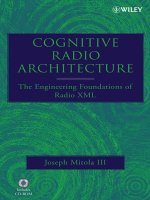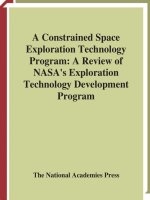Fette b a (ed) cognitive radio technology
Bạn đang xem bản rút gọn của tài liệu. Xem và tải ngay bản đầy đủ của tài liệu tại đây (7.35 MB, 649 trang )
Cognitive Radio Technology
This page intentionally left blank
Cognitive Radio Technology
Edited by Bruce A. Fette
AMSTERDAM
•
•
•
NEW YORK
BOSTON
•
SAN FRANCISCO
•
OXFORD
•
HEIDELBERG
•
PARIS
SINGAPORE
•
•
•
LONDON
SAN DIEGO
SYDNEY
Newness is an important of Elsevier
•
TOKYO
Newnes is an imprint of Elsevier
30 Corporate Drive, Suite 400, Burlington, MA 01803, USA
Linacre House, Jordan Hill, Oxford OX2 8DP, UK
Copyright © 2006, Elsevier Inc. All rights reserved.
No part of this publication may be reproduced, stored in a retrieval system, or
transmitted in any form or by any means, electronic, mechanical, photocopying,
recording, or otherwise, without the prior written permission of the publisher.
Permissions may be sought directly from Elsevier’s Science & Technology Rights
Department in Oxford, UK: phone: (ϩ44) 1865 843830, fax: (ϩ44) 1865 853333,
E-mail: HYPERLINK "mailto:"
You may also complete your request on-line via the Elsevier homepage (),
by selecting “Support & Contact” then “Copyright and Permission” and then “Obtaining
Permissions.”
Recognizing the importance of preserving what has been written, Elsevier prints its books
on acid-free paper whenever possible.
Library of Congress Cataloging-in-Publication Data
Cognitive radio technology / edited by Bruce A. Fette.—1st ed.
p. cm.—(Communications engineering series)
Includes bibliographical references and index
ISBN-13: 978-0-7506-7952-7 (alk. paper)
ISBN-10: 0-7506-7952-2 (alk. paper)
1. Software radio. 2. Artificial intelligence. 3. Wireless communication systems. I. Fette, Bruce A.
II. Series.
TK5103.4875.C64
621.384—dc22
2006
British Library Cataloguing-in-Publication Data
A catalogue record for this book is available from the British Library.
ISBN 13: 978-0-7506-7952-7
ISBN 10: 0-7506-7952-2
For information on all Newnes publications visit our Web site at
www.books.elsevier.com
06 07 08 09 10
10 9 8 7 6 5 4 3 2 1
Typeset by Charon Tec Ltd, Chennai, India
www.charontec.com
Printed in the United States of America
2006016824
Contents
List of Contributors .................................................................. xvii
Foreword.................................................................................. xxi
Chapter 1: History and Background of Cognitive Radio
Technology Bruce A. Fette ....................................................... 1
1.1
1.2
1.3
1.4
1.5
1.6
1.7
1.8
The Vision of Cognitive Radio..............................................................1
History and Background Leading to Cognitive Radio ..........................2
A Brief History of SDR ........................................................................4
Basic SDR .............................................................................................8
1.4.1 The Hardware Architecture of an SDR..................................8
1.4.2 Computational Processing Resources in an SDR ................11
1.4.3 The Software Architecture of an SDR .................................13
1.4.4 Java Reflection in a Cognitive Radio ...................................15
1.4.5 Smart Antennas in a Cognitive Radio..................................15
Spectrum Management .......................................................................17
1.5.1 Managing Unlicensed Spectrum ..........................................18
1.5.2 Noise Aggregation ...............................................................19
1.5.3 Aggregating Spectrum Demand and Use
of Subleasing Methods.........................................................21
1.5.4 Priority Access .....................................................................22
US Government Roles in Cognitive Radio .........................................22
1.6.1 DARPA ................................................................................22
1.6.2 FCC ......................................................................................23
1.6.3 NSF/CSTB Study.................................................................23
How Smart Is Useful? .........................................................................24
Organization of this Book ...................................................................25
v
Contents
Chapter 2: Communications Policy and Spectrum
Management Paul Kolodzy .................................................. 29
2.1 Introduction.........................................................................................29
2.2 Cognitive Radio Technology Enablers................................................30
2.3 New Opportunities in Spectrum Access .............................................33
2.3.1 Current Spectrum Access Techniques .................................33
2.3.2 Opportunistic Spectrum Access...........................................39
2.3.3 Dynamic Frequency Selection .............................................42
2.4 Policy Challenges for Cognitive Radios .............................................42
2.4.1 Dynamic Spectrum Access ..................................................43
2.4.2 Security ................................................................................46
2.4.3 Communications Policy before Cognitive Radio.................48
2.4.4 Cognitive Radio Impact on Communications Policy...........49
2.4.5 US Telecommunications Policy, Beginning with
the Titanic.............................................................................49
2.4.6 US Telecommunications Policy: Keeping Pace
with Technology...................................................................51
2.5 Telecommunications Policy and Technology Impact
on Regulation ......................................................................................53
2.5.1 Basic Geometries .................................................................53
2.5.2 Introduction of Dynamic Policies ........................................56
2.5.3 Introduction of Policy-Enabled Devices ..............................58
2.5.4 Interference Avoidance ........................................................60
2.5.5 Overarching Impact .............................................................61
2.6 Global Policy Interest in Cognitive Radios.........................................61
2.6.1 Global Interest......................................................................62
2.6.2 US Reviews of Cognitive Radios for Dynamic
Spectrum Access..................................................................62
2.7 Summary .............................................................................................69
Chapter 3: The Software Defined Radio as a Platform
for Cognitive Radio Pablo Robert and Bruce A. Fette ................. 73
3.1 Introduction.........................................................................................73
3.2 Hardware Architecture ........................................................................75
3.2.1 The Block Diagram..............................................................76
3.2.2 Baseband Processor Engines................................................82
3.2.3 Baseband Processing Deployment.......................................87
3.2.4 Multicore Systems and System-on-Chip .............................89
vi
Contents
3.3 Software Architecture .........................................................................90
3.3.1 Design Philosophies and Patterns ........................................91
3.4 SDR Development and Design ...........................................................94
3.4.1 GNURadio ...........................................................................94
3.4.2 Software Communications Architecture..............................95
3.5 Applications ......................................................................................108
3.5.1 Application Software .........................................................108
3.6 Development .....................................................................................111
3.6.1 Component Development ..................................................112
3.6.2 Waveform Development ....................................................113
3.7 Cognitive Waveform Development ...................................................114
3.8 Summary ...........................................................................................116
Chapter 4: Cognitive Radio: The Technologies
Required John Polson ....................................................... 119
4.1 Introduction.......................................................................................119
4.2 Radio Flexibility and Capability .......................................................120
4.2.1 Continuum of Radio Flexibility and Capability.................120
4.2.2 Examples of Software Capable Radios..............................121
4.2.3 Examples of Software Programmable Radios ...................126
4.2.4 Examples of SDR...............................................................126
4.3 Aware, Adaptive, and CRs ................................................................126
4.3.1 Aware Radios .....................................................................126
4.3.2 Adaptive Radios.................................................................131
4.3.3 Cognitive Radios................................................................132
4.4 Comparison of Radio Capabilities and Properties ............................133
4.5 Available Technologies for CRs........................................................133
4.5.1 Geolocation ........................................................................135
4.5.2 Spectrum Awareness/Frequency Occupancy .....................135
4.5.3 Biometrics ..........................................................................136
4.5.4 Time ...................................................................................136
4.5.5 Spatial Awareness or Situational Awareness .....................138
4.5.6 Software Technology .........................................................138
4.5.7 Spectrum Awareness and Potential for Sublease
or Borrow ...........................................................................144
4.6 Funding and Research in CRs...........................................................144
4.6.1 Cognitive Geolocation Applications..................................146
4.6.2 Dynamic Spectrum Access and Spectrum Awareness ......148
vii
Contents
4.6.3 The Rendezvous Problem ..................................................153
4.6.4 CR Authentication Applications ........................................155
4.7 Timeline for CRs...............................................................................156
4.7.1 Decisions, Directions, and Standards.................................157
4.7.2 Manufacture of New Products ...........................................157
4.8 Summary and Conclusions................................................................158
Chapter 5: Spectrum Awareness
5.1
5.2
5.3
5.4
5.5
5.6
5.7
5.8
5.9
5.10
Preston Marshall .................... 163
Introduction .....................................................................................163
The Interference Avoidance Problem..............................................164
Cognitive Radio Role ......................................................................165
Spectral Footprint Minimization .....................................................166
Creating Spectrum Awareness.........................................................168
5.5.1 Spectrum Usage Reporting ................................................168
5.5.2 Spectrum Sensing...............................................................169
5.5.3 Potential Interference Analysis ..........................................170
5.5.4 Link Rendezvous ...............................................................173
5.5.5 Distributed Sensing and Operation ....................................173
Channel Awareness and Multiple Signals in Space ........................174
Spectrally Aware Networking .........................................................176
Overlay and Underlay Techniques ..................................................178
Adaptive Spectrum Implications for Cognitive
Radio Hardware...............................................................................180
Summary: The Cognitive Radio Toolkit .........................................182
Appendix: Propagation Energy Loss...............................................183
Chapter 6: Cognitive Policy Engines
Robert J. Wellington ........... 185
6.1 The Promise of Policy Management for Radios ...............................185
6.2 Background and Definitions..............................................................185
6.3 Spectrum Policy ................................................................................187
6.3.1 Management of Spectrum Policy.......................................188
6.3.2 System Requirements for Spectrum Policy
Management.......................................................................189
6.4 Antecedents for Cognitive Policy Management................................189
6.4.1 Defense Advanced Research Projects Agency
Policy Management Projects..............................................190
6.4.2 Academic Research in Policy Management ......................191
viii
Contents
6.5
6.6
6.7
6.8
6.4.3 Commercial Applications of Policy Management .............194
6.4.4 Standardization Efforts for Policy Management................195
Policy Engine Architectures for Radio .............................................198
6.5.1 Concept for Policy Engine Operations ..............................198
6.5.2 Technical Approaches for Policy Management .................200
6.5.3 Enabling Technologies.......................................................202
Integration of Policy Engines into Cognitive Radio .........................204
6.6.1 Software Communications Architecture Integration .........204
6.6.2 Policy Engine Design.........................................................206
6.6.3 Integration of the Radio into a Network Policy
Management Architecture..................................................209
The Future of Cognitive Policy Management ...................................211
6.7.1 Military Opportunities for Cognitive Policy
Management.......................................................................211
6.7.2 Commercial Opportunities for Spectrum
Management.......................................................................212
6.7.3 Obstacles to Adoption of Policy Management
Architectures ......................................................................213
Summary ...........................................................................................214
Chapter 7: Cognitive Techniques: Physical and Link
Layers Thomas W. Rondeau and Charles W. Bostian ................ 219
7.1 Introduction.......................................................................................219
7.2 Optimizing PHY and Link Layers for Multiple-Objectives
Under Current Channel Conditions...................................................220
7.3 Defining the Cognitive Radio............................................................222
7.4 Developing Radio Controls (Knobs) and Performance
Measures (Meters).............................................................................223
7.4.1 PHY- and Link-Layer Parameters ......................................223
7.4.2 Modeling Outcome as a Primary Objective .......................227
7.5 MODM Theory and Its Application to Cognitive Radio ..................230
7.5.1 Definition of MODM and Its Basic Formulation...............230
7.5.2 Constraint Modeling ..........................................................231
7.5.3 The Pareto-Optimal Front: Finding the Nondominated
Solutions ............................................................................231
7.5.4 Why the Radio Environment Is a MODM Problem ..........232
7.5.5 GA Approach to the MODM .............................................233
ix
Contents
7.6 The Multi-objective GA for Cognitive Radios..................................239
7.6.1 Cognition Loop ..................................................................239
7.6.2 Representing Radio Parameters as Genes
in a Chromosome ...............................................................244
7.6.3 Multi-dimensional Analysis of the Chromosomes ............245
7.6.4 Relative Pooling Tournament Evaluation ..........................249
7.6.5 Example of the WSGA ......................................................249
7.7 Advanced GA Techniques ..............................................................252
7.7.1 Population Initialization.....................................................253
7.7.2 Priming the GA with Previously Observed Solutions .......254
7.7.3 CBDT Initialization of GAs...............................................255
7.8 Need for a Higher-Layer Intelligence .............................................258
7.8.1 Adjusting Parameters Autonomously to
Achieve Goals ....................................................................258
7.8.2 Rewards for Good Behavior and Punishments
for Poor Performance.........................................................258
7.9 How the Intelligent Computer Operates .........................................260
7.9.1 Sensing and Environmental Awareness .............................261
7.9.2 Decision-Making and Optimization...................................262
7.9.3 Case-Based Learning .........................................................262
7.9.4 Weight Values and Objective Functions ............................263
7.9.5 Distributed Learning ..........................................................263
7.10 Summary .........................................................................................263
Chapter 8: Cognitive Techniques: Position Awareness
John Polson and Bruce A. Fette ............................................... 269
8.1 Introduction.......................................................................................269
8.2 Radio Geolocation and Time Services ..............................................270
8.2.1 GPS ....................................................................................271
8.2.2 Coordinate System Transformations..................................275
8.2.3 GPS Geolocation Summary ...............................................275
8.3 Network Localization........................................................................276
8.3.1 Spatially Variant Network Service Availability .................276
8.3.2 Geolocation-Enabled Routing............................................278
8.3.3 Miscellaneous Functions....................................................278
8.4 Additional Geolocation Approaches .................................................278
8.4.1 Time-Based Approaches ....................................................279
8.4.2 AOA Approach ..................................................................286
x
Contents
8.5
8.6
8.7
8.8
8.9
8.4.3 RSS Approach....................................................................287
Network-Based Approaches..............................................................288
Boundary Decisions ..........................................................................288
8.6.1 Regulatory Region Selection .............................................288
8.6.2 Policy Servers and Regions................................................292
8.6.3 Other Uses of Boundary Decisions....................................293
Example of Cellular Telephone 911 Geolocation for First
Responders ........................................................................................293
Interfaces to Other Cognitive Technologies......................................294
8.8.1 Interface to Policy Engines ................................................294
8.8.2 Interface to Networking Functions ....................................295
8.8.3 Interface to Planning Engines ............................................295
8.8.4 Interface to User.................................................................295
Summary ...........................................................................................295
Chapter 9: Cognitive Techniques: Network
Awareness Jonathan M. Smith ........................................... 299
9.1
9.2
9.3
9.4
9.5
9.6
9.7
Introduction.......................................................................................299
Applications and their Requirements ................................................300
Network Solutions to Requirements .................................................302
Coping with the Complex Trade-Space ............................................304
Cognition to the Rescue ....................................................................306
The DARPA SAPIENT Program ......................................................308
Summary ...........................................................................................310
Chapter 10: Cognitive Services for the User
Joseph P.
Campbell, William M. Campbell, Scott M. Lewandowski
and Clifford J. Weinstein ....................................................... 313
10.1 Introduction.....................................................................................313
10.2 Speech and Language Processing ...................................................314
10.2.1 Speaker Recognition ........................................................314
10.2.2 Language Identification ...................................................323
10.2.3 Text-to-Speech Conversion ..............................................325
10.2.4 Speech-to-Text Conversion ..............................................325
10.2.5 Machine Translation ........................................................326
10.2.6 Background Noise Suppression .......................................327
10.2.7 Speech Coding .................................................................328
10.2.8 Speaker Stress Characterization.......................................329
xi
Contents
10.2.9 Noise Characterization.....................................................329
10.3 Concierge Services..........................................................................330
10.4 Summary .........................................................................................332
Chapter 11: Network Support: The Radio Environment
Map Youping Zhao, Bin Le and Jeffrey H. Reed ...................... 337
11.1
11.2
11.3
11.4
11.5
11.6
11.7
11.8
Introduction.....................................................................................337
Internal and External Network Support ..........................................338
Introduction to the REM .................................................................339
REM Infrastructure Support to Cognitive Radios...........................341
11.4.1 The Role of the REM in Cognitive Radio........................341
11.4.2 REM Design.....................................................................341
11.4.3 Enabling Techniques for Implementing REM .................343
Obtaining Awareness with the REM...............................................345
11.5.1 Awareness: Prerequisite for Cognitive Radio ..................345
11.5.2 Classification of Awareness .............................................347
11.5.3 Obtaining SA ...................................................................349
Network Support Scenarios and Applications ................................353
11.6.1 Infrastructure-Based Network and Centralized
Global REM .....................................................................354
11.6.2 Ad hoc Mesh Networks and Distributed
Local REMs .....................................................................355
Supporting Elements to the REM ...................................................357
Summary and Open Issues..............................................................360
Chapter 12: Cognitive Research: Knowledge Representation
and Learning Vincent J. Kovarik Jr. ..................................... 365
12.1 Introduction.....................................................................................365
12.2 Knowledge Representation and Reasoning.....................................369
12.2.1 Symbolic Representation .................................................371
12.2.2 Ontologies and Frame Systems........................................372
12.2.3 Behavioral Representation ...............................................374
12.2.4 Case-Based Reasoning.....................................................375
12.2.5 Rule-Based Systems.........................................................377
12.2.6 Temporal Knowledge.......................................................378
12.2.7 Knowledge Representation Summary..............................379
12.3 Machine Learning ...........................................................................380
12.3.1 Memorization...................................................................381
xii
Contents
12.3.2 Classifiers.........................................................................382
12.3.3 Bayesian Logic.................................................................383
12.3.4 Decision Trees..................................................................385
12.3.5 Reinforcement-Based Learning .......................................386
12.3.6 Temporal Difference ........................................................389
12.3.7 Neural Networks ..............................................................390
12.3.8 Genetic Algorithms..........................................................392
12.3.9 Simulation and Gaming ...................................................393
12.4 Implementation Considerations ......................................................394
12.4.1 Computational Requirements...........................................394
12.4.2 Brittleness and Edge Conditions......................................394
12.4.3 Predictable Behavior ........................................................395
12.5 Summary .........................................................................................396
Chapter 13: Roles of Ontologies in Cognitive Radios
Mieczyslaw M. Kokar, David Brady and Kenneth Baclawski ........... 401
13.1 Introduction to Ontology-Based Radio...........................................401
13.2 Knowledge-Intensive Characteristics of Cognitive Radio
401
13.2.1 Knowledge of Constraints and Requirements..................403
13.2.2 Information Collection and Fusion ..................................404
13.2.3 Situation Awareness and Advice......................................404
13.2.4 Self-awareness .................................................................405
13.2.5 Query by User, Self, or Other Radio................................405
13.2.6 Query Responsiveness and Command Execution ...........405
13.2.7 Negotiation for Resources................................................406
13.2.8 Dynamic Interoperability at Any Stack Layer .................406
13.3 Ontologies and Their Roles in Cognitive Radio .............................407
13.3.1 Introduction......................................................................407
13.3.2 Role of Ontology in Knowledge-Intensive
Applications .....................................................................413
13.4 A Layered Ontology and Reference Model ....................................414
13.4.1 Physical Layer Ontology..................................................414
13.4.2 Data Link Layer Ontology ...............................................416
13.5 Examples.........................................................................................421
13.5.1 Responding to Delays and Errors ....................................421
13.5.2 Adaptation of Training Sequence Length ........................423
13.5.3 Data Link Layer Protocol Consistency
and Selection....................................................................425
xiii
Contents
13.6 Open Research Issues .....................................................................427
13.6.1 Ontology Development and Consensus ...........................427
13.6.2 Ontology Mapping ...........................................................428
13.6.3 Learning ...........................................................................429
13.6.4 Efficiency of Reasoning ...................................................430
13.7 Summary .........................................................................................431
Chapter 14: Cognitive Radio Architecture
Joseph Mitola III ................................................................. 435
14.1 Introduction.....................................................................................435
14.2 CRA I: Functions, Components, and Design Rules........................436
14.2.1 AACR Functional Component Architecture....................436
14.2.2 Design Rules Include Functional Component
Interfaces..........................................................................441
14.2.3 Near-Term Implementations ............................................448
14.2.4 The Cognition Components .............................................450
14.2.5 Self-referential Components ............................................455
14.2.6 Flexible Functions of the Component Architecture.........458
14.3 CRA II: The Cognition Cycle .........................................................460
14.3.1 The Cognition Cycle ........................................................460
14.3.2 Observe (Sense and Perceive)..........................................461
14.3.3 Orient ...............................................................................462
14.3.4 Plan ..................................................................................463
14.3.5 Decide ..............................................................................464
14.3.6 Act....................................................................................464
14.3.7 Learning ...........................................................................464
14.3.8 Self-monitoring ................................................................465
14.4 CRA III: The Inference Hierarchy..................................................466
14.4.1 Atomic Stimuli.................................................................468
14.4.2 Primitive Sequences: Words and Dead Time ...................469
14.4.3 Basic Sequences...............................................................469
14.4.4 NL in the CRA Inference Hierarchy................................470
14.4.5 Observe–Orient Links for Scene Interpretation
472
14.4.6 Observe–Orient Links for Radio Skill Sets .....................473
14.4.7 General World Knowledge...............................................474
14.5 CRA IV: Architecture Maps ...........................................................476
14.5.1 CRA Topological Maps ...................................................477
14.5.2 CRA Identifies Self, Owner, and Home Network............478
xiv
Contents
14.6
14.7
14.8
14.9
14.5.3 CRA-Reinforced Hierarchical Sequences........................478
14.5.4 Behaviors in the CRA ......................................................479
14.5.5 From Maps to APIs..........................................................481
14.5.6 Industrial-Strength Inference Hierarchy ..........................481
CRA V: Building the CRA on SDR Architectures .........................483
14.6.1 Review of SWR and SDR Principles ...............................483
14.6.2 Radio Architecture ...........................................................486
14.6.3 The SCA...........................................................................487
14.6.4 Functions-Transforms Model of Radio............................490
14.6.5 Architecture Migration: From SDR to AACR.................491
14.6.6 Cognitive Electronics.......................................................491
14.6.7 When Should a Radio Transition toward Cognition? ......492
14.6.8 Radio Evolution toward the CRA ....................................494
Cognition Architecture Research Topics ........................................494
Industrial-Strength AACR Design Rules........................................495
Summary and Future Directions .....................................................497
Chapter 15: Cognitive Radio Performance Analysis James O. Neel,
Jeffrey H. Reed and Allen B. MacKenzie .................................... 501
15.1 Introduction.....................................................................................501
15.2 The Analysis Problem.....................................................................505
15.2.1 Mathematical Preliminaries .............................................505
15.2.2 A Formal Model of a Cognitive Radio Network .............506
15.2.3 Analysis Objectives..........................................................509
15.3 Traditional Engineering Analysis Techniques ................................513
15.3.1 A Dynamical Systems Approach .....................................513
15.3.2 Contraction Mappings and the General Convergence
Theorem ...........................................................................518
15.3.3 Markov Models ................................................................524
15.4 Applying Game Theory to the Analysis Problem...........................529
15.4.1 Basic Elements of Game Theory .....................................530
15.4.2 Mapping the Basic Elements of a Game
to the Cognition Cycle .....................................................533
15.4.3 Basic Game Models .........................................................534
15.4.4 Basic Game Theory Analysis Techniques .......................538
15.5 Relevant Game Models ...................................................................544
15.5.1 Potential Games ...............................................................544
15.5.2 Supermodular Games.......................................................554
xv
Contents
15.6 Case Studies ....................................................................................563
15.6.1 Distributed Power Control ...............................................563
15.6.2 Dynamic Frequency Selection .........................................568
15.6.3 Adaptive Interference Avoidance.....................................569
15.7 Summary and Conclusions .............................................................572
15.8 Questions.........................................................................................575
Chapter 16: The Really Hard Problems
Bruce A. Fette .............. 581
16.1 Introduction.....................................................................................581
16.2 Review of the Book.........................................................................581
16.3 Services Offered to Wireless Networks through Infrastructure ......587
16.3.1 Stand-Alone Radios with Cognition ................................588
16.3.2 Cellular Infrastructure Support to Cognition ...................589
16.3.3 Data Radios......................................................................590
16.3.4 Cognitive Services Offered through Infrastructure..........591
16.3.5 The Remaining Hard Problems........................................593
Glossary ................................................................................. 595
Index...................................................................................... 609
xvi
List of Contributors
William M. Campbell
Information Systems Technology
Group
MIT Lincoln Laboratory
244 Wood Street, C-243
Lexington, MA, 02420-9185
Email:
Kenneth Baclawski
Computer and Information Science
Northeastern University
360 Huntington Avenue
Boston, MA, 02115
Charles W. Bostian
Wireless @ Virginia Tech
Bradley Department of Electrical
and Computer Engineering
Virginia Tech
Mail Code 0111
Blacksburg, VA, 24060-0111
Email:
Bruce A. Fette
Chief Scientist
Communication Networks Division
General Dynamics C4 Systems
8220 E Roosevelt
Scottsdale, AZ, 85257
Email:
David Brady
ECE Dept
Northeastern University
360 Huntington Avenue
Boston MA, 02115
Email:
Mieczyslaw M. Kokar
Department of Electrical and
Computer Engineering
Northeastern University
360 Huntington Avenue
Boston, MA, 02115
Email:
Joseph P. Campbell
Senior MTS
Information Systems Technology
Group
MIT Lincoln Laboratory
244 Wood Street, C-290A
Lexington, MA, 02420-9185
Email:
Paul Kolodzy
Kolodzy Consulting
P.O. Box 1443
Centerville, VA, 20120
Email:
xvii
List of Contributors
Vincent J. Kovarik Jr.
Harris Corporation
Mail Stop W2-11F
P.O. Box 37
Melbourne FL, 32902-0037
Email:
Bin Le
Center for Wireless
Telecommunications
Wireless @ Virginia Tech
Bradley Department of Electrical
and Computer Engineering
Virginia Tech, Mail Code 0111
Blacksburg, VA, 24061-0111
Email:
Scott M. Lewandowski
Information Systems Technology
Group
MIT Lincoln Laboratory
244 Wood Street, C-256
Lexington, MA, 02420-9185
Email:
Preston Marshall
Defense Advanced Research Projects
Agency
Email:
Allen B. MacKenzie
Bradley Department of Electrical
and Computer Engineering
Virginia Polytechnic Institute and
State University, Mail Code 0111
Blacksburg, VA, 24061-0111
Email:
Joseph Mitola III
Consulting Scientist
Tampa, FL, 33604
Email:
James O. Neel
Mobile and Portable Radio Research
Group
Wireless @ Virginia Tech
Bradley Department of Electrical
and Computer Engineering
Virginia Tech
432 Durham Hall, MS 0350
Blacksburg, VA, 24061
Email:
John Polson
Principal Engineer
Bell Helicopter, Textron Inc.
P.O. Box 482
Fort Worth, TX, 76101
Email: jtpolson@bellhelicopter.
textron.com
Jeffrey H. Reed
Mobile and Portable Radio Research
Group
Wireless @ Virginia Tech
Bradley Department of Electrical
and Computer Engineering
Virginia Tech
432 Durham Hall, MS 350
Blacksburg, VA, 24061
Email:
xviii
List of Contributors
Clifford J. Weinstein
Group Leader
Information Systems Technology
Group
MIT Lincoln Laboratory
244 Wood Street, C-290A
Lexington, MA, 02420-9185
Email:
Pablo Robert
Mobile and Protable Radio Research
Group (MPRG)
Bradley Department of Electrical
and Computer Engineering
Virginia Tech
Blacksburg, VA, 24060-0111
Email:
Robert J. Wellington
University of Minnesota
9740 Russel Circle S.
Bloomington MN, 55431
Email:
Thomas W. Rondeau
Bradley Department of Electrical
and Computer Engineering
Virginia Tech
Mail Code 0111
Blacksburg, VA, 24060-0111
Email:
Youping Zhao
Mobile and Portable Radio Research
Group
Wireless @ Virginia Tech
432 Durham Hall, MS 350
Blacksburg, VA, 24061
Email:
Jonathan M. Smith
Defense Advanced Research Projects
Agency
Email:
xix
This page intentionally left blank
Foreword
This introduction takes a visionary look at ideal cognitive radios (CRs) that integrate advanced software-defined radios (SDR) with CR techniques to arrive at
radios that learn to help their user using computer vision, high-performance
speech understanding, global positioning system (GPS) navigation, sophisticated
adaptive networking, adaptive physical layer radio waveforms, and a wide range
of machine learning processes.
CRs Know Radio Like TellMe® Knows 800 Numbers
When you dial 1-800-555-1212, a speech synthesis algorithm says “Toll Free
Directory Assistance powered by TellMe® Networks (www.tellme.com, Mountain
View, CA, 2005). Please say the name of the listing you want.” If you mumble it
says, “OK, United Airlines. If that is not what you wanted press 9, otherwise wait
while I look up the number.” Reportedly, some 99 percent of the time TellMe gets
it right, replacing the equivalent of thousands of directory assistance operators of
yore. TellMe, a speech-understanding system, achieves a high degree of success
by its focus on just one task: finding a toll-free telephone number. Narrow task
focus is one key to algorithm successes.
The cognitive radio architecture (CRA) is the building block from which to
build cognitive wireless networks (CWNs), the wireless mobile offspring of
TellMe. CRs and networks are emerging as practical, real-time, highly focused
applications of computational intelligence technology. CRs differ from the more
general artificial intelligence (AI) based services like intelligent agents, computer
speech, and computer vision in degree of focus. Like TellMe, CRs focus on
very narrow tasks. For CRs, the task is to adapt radio-enabled information services to the specific needs of a specific user. TellMe, a network service, requires
Note: Adapted from J. Mitola III, Aware, Adaptive and Cognitive Radio: The Engineering
Foundations of Radio XML, Wiley, 2006.
xxi
Foreword
substantial network computing resources to serve thousands of users at once.
CWNs, on the other hand, may start with a radio in your purse or on your belt, a
cell phone on steroids, focused on the narrow task of creating from the myriad
available wireless information networks and resources just what is needed by just
one user: you. Each CR fanatically serves the needs and protects the personal
information of just one owner via the CRA using its audio and visual sensory perception and automated machine learning (AML).
TellMe is here and now, while CRs are emerging in global wireless research
centers and industry forums like the SDR Forum and Wireless World Research
Forum (WWRF). This book introduces the technologies to bootstrap CR systems,
introducing technical challenges and approaches, emphasizing CR as a technology
enabler for rapidly emerging commercial CWN services.
CRs See What You See, Discovering Radio Frequency Uses,
Needs, and Preferences
Although the common cell phone may have a camera, it lacks vision algorithms,
so it does not know what it is seeing. It can send a video clip, but it has no
perception of the visual scene in the clip. If it had vision-processing algorithms,
it could perceive and understand the visual scene. It could tell whether it were at
home, in the car, at work, shopping, or driving up the driveway on the way
home. If vision algorithms show it that you are entering your driveway in your
car, a CR could learn to open the garage door for you wirelessly. Thus, you
would not need to fish for the garage door opener, yet another wireless gadget.
In fact, you do not need a garage door opener anymore, once CRs enter the
market. To open the car door, you will not need a key fob either. As you approach
your car, your personal CR perceives the common scene and, as trained,
synthesizes the fob radio frequency (RF) transmission and opens the car door
for you.
CRs do not attempt everything. They learn about your radio use patterns
because they know a lot about radio, generic users, and legitimate uses of radio.
CRs have the a priori knowledge needed to detect opportunities to assist you with
your use of the radio spectrum accurately, delivering that assistance with minimum intrusion.
Products realizing the visual perception of this vignette are demonstrated
on laptop computers today. Reinforcement learning (RL) and case-based reasoning (CBR) are mature AML technologies with radio network applications now
being demonstrated in academic and industrial research settings as technology
xxii
Foreword
pathfinders for CR1 and CWN.2 Two or three Moore’s law cycles or 3 to 5 years
from now, these vision and learning algorithms will fit in your cell phone. In the
interim, CWNs will begin to offer such services, presenting consumers with new
tradeoffs between privacy and ultra-personalized convenience.
CRs Hear What You Hear, Augmenting Your Personal Skills
The cell phone on your waist is deaf. Although your cell phone has a microphone,
it lacks embedded speech-understanding technology, so it does not perceive what
it hears. It can let you talk to your daughter, but it has no perception of your
daughter, nor of the content of your conversation. If it had speech-understanding
technology, it could perceive your speech dialog. It could detect that you and your
daughter are talking about common subjects like homework or your favorite song.
With CR, speech algorithms would detect your daughter saying that your favorite
song is now playing on WDUV. As an SDR, not just a cell phone, your CR then
could tune to FM 105.5 so that you can hear “The Rose.”
With your CR, you no longer need a transistor radio. Your CR eliminates from
your pocket, purse or backpack yet another RF gadget. In fact, you may not need
iPOD®, Game Boy® and similar products as high-end CRs enter the market (or
iPODs or Game Boys with CR may become the single pocket pal instead: you never
know how market demand will shape products toward the “killer app,” do you?).
Your CR could learn your radio listening and information use patterns, accessing
songs, downloading games, snipping broadcast news, sports, and stock quotes as
you like as the CR re-programs its internal SDR to better serve your needs and
preferences. Combining vision and speech perception, as you approach your car your
CR perceives this common scene and, as you had the morning before, tunes your car
radio to WTOP for your favorite “Traffic and weather together on the eights.”
1
Mitola’s reference for CR pathfinders.
Semantic Web: Researchers formulate CRs as sufficiently speech-capable to answer questions
about <Self/> and the <Self/> use of <Radio/> in support of its <Owner/>. When an ordinary concept like “owner” has been translated into a comprehensive ontological structure of Computational
primitives, for example, via Semantic Web technology, the concept becomes a computational
primitive for autonomous reasoning and information exchange. Radio XML, an emerging CR
derivative of the eXtensible Markup Language, XML, offers to standardize such radio-scene perception primitives. They are highlighted in this brief treatment by <Angle-brackets/>. All CR have
a <Self/>, a <Name/>, and an <Owner/>. The <Self/> has capabilities like <GSM/> and <SDR/>,
a self-referential computing architecture, which is guaranteed to crash unless its computing
ability is limited to real-time response tasks; this is appropriate for CR but may be too limiting
for general-purpose computing.
2
xxiii
Foreword
For AML, CRs need to save speech, RF, and visual cues, all of which may be
recalled by the user, expanding the user’s ability to remember details of conversations and snapshots of scenes, augmenting the skills of the <owner/>.3 Because of
the brittleness of speech and vision technologies, CRs try to “remember everything” like a continuously running camcorder. Since CRs detect content, such as
speakers’ names, and keywords like “radio” and “song,” they can retrieve some
content asked for by the user, expanding the user’s memory in a sense. CRs thus
could enhance the personal skills of their users, such as memory for detail.
CRs Learn to Differentiate Speakers to Reduce Confusion
To further limit combinatorial explosion in speech, CR may form speaker models,
statistical summaries of the speech patterns of speakers, particularly of the
<Owner/>. Speaker modeling is particularly reliable when the <Owner/> uses the
CR as a cell phone to place a phone call. Contemporary speaker recognition algorithms differentiate male from female speakers with high accuracy. With a few
different speakers to be recognized (i.e., fewer than 10 in a family) and with reliable side information like the speaker’s telephone number, today’s state-of-the-art
algorithms recognize individual speakers with better than 95 percent accuracy.
Over time, each CR learns the speech patterns of its <Owner/> in order to
learn from the <Owner/> and not be confused by other speakers. CR thus leverages experience incrementally to achieve increasingly sophisticated dialog. Today,
a 3 GHz laptop supports this level of speech understanding and dialog synthesis in
real time, making it likely to be available in a cell phone in 3 to 5 years.
The CR must both know a lot about radio and learn a lot about you, the
<Owner/>, recording and analyzing personal information and thus placing a premium on trustworthy privacy technologies. Increased autonomous customization
of wireless service include secondary use of broadcast spectrum. Therefore, the
CRA incorporates speech recognition to enable learning without requiring overwhelming amounts of training, allowing it to become sufficiently helpful without
being a nuisance.
More Flexible Secondary Use of Radio Spectrum
In 2004, the US Federal Communications Commission (FCC) issued a Report and
Order that radio spectrum allocated to TV, but unused in a particular broadcast
3
Ibid.
xxiv









